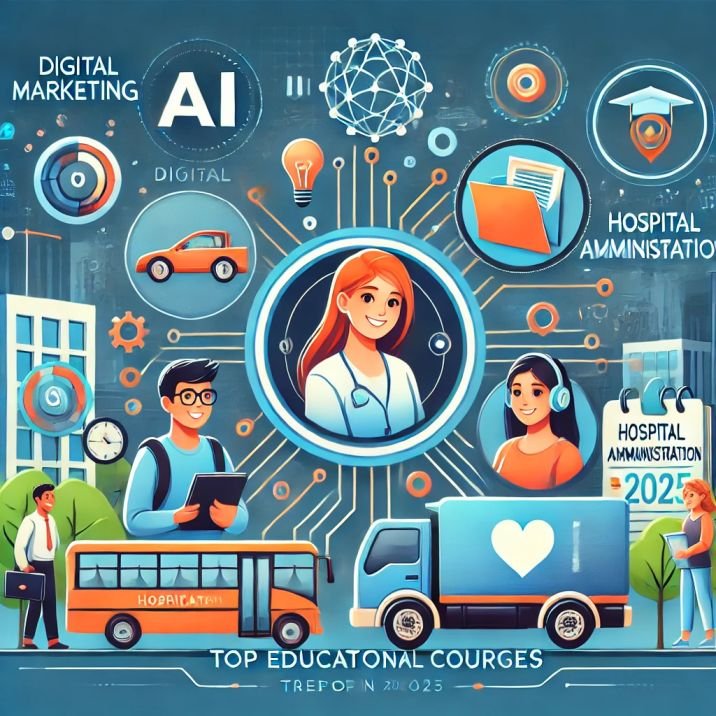
Top Educational Courses Trending in Kerala for 2025
The demand for professional courses in Kerala has been rising steadily, with students and professionals seeking career-oriented programs to enhance their job prospects. As industries evolve, acquiring specialized skills becomes essential to stay ahead in the competitive job market. In 2025, some of the most trending educational courses in Kerala include AI with Data Science, Digital Marketing with Designing, Hospital Administration, Logistics and Supply Chain Management, and Accounting Courses. These programs are shaping the future of education and employment opportunities in the state. Let’s explore why these Top Educational Courses Trending in Kerala for 2025 are in high demand and how they can boost your career.
1. AI with Data Science
Why AI with Data Science?
Artificial Intelligence (AI) and Data Science are transforming industries across the globe. With the increasing reliance on automation, machine learning, and big data analytics, professionals with AI and Data Science expertise are in high demand.
Career Opportunities
- Data Scientist
- AI Engineer
- Machine Learning Specialist
- Business Intelligence Analyst
- Data Analyst
Key Skills You Will Learn
- Python and R Programming
- Machine Learning and Deep Learning
- Data Visualization and Analytics
- AI Model Development
- Big Data Technologies
2. Digital Marketing with Designing
Why Digital Marketing with Designing?
With the exponential growth of online businesses and e-commerce, digital marketing has become a crucial skill. Combining it with designing skills enhances a professional’s ability to create visually appealing and effective marketing campaigns.
Career Opportunities
- Digital Marketing Specialist
- Social Media Manager
- SEO Expert
- UI/UX Designer
- Content Marketer
Key Skills You Will Learn
- SEO (Search Engine Optimization)
- Social Media Marketing
- Graphic and Web Designing
- Google Ads and PPC Advertising
- Content Creation and Branding
3. Hospital Administration
Why Hospital Administration?
The healthcare industry is one of the fastest-growing sectors in Kerala. Hospital Administration is a crucial field that ensures the efficient functioning of healthcare facilities.
Career Opportunities
- Hospital Administrator
- Healthcare Consultant
- Medical Office Manager
- Patient Services Coordinator
- Health Information Manager
Key Skills You Will Learn
- Healthcare Operations Management
- Medical Ethics and Regulations
- Hospital Financial Management
- Patient Relationship Management
- Human Resource Management in Healthcare
4. Logistics and Supply Chain Management
Why Logistics and Supply Chain Management?
With the rapid expansion of e-commerce, global trade, and retail businesses, Logistics and Supply Chain Management have become critical components of the economy.
Career Opportunities
- Supply Chain Manager
- Logistics Coordinator
- Warehouse Manager
- Procurement Officer
- Operations Analyst
Key Skills You Will Learn
- Inventory Management
- Transportation and Distribution
- Supply Chain Optimization
- Risk Management
- Logistics Planning and Execution
5. Accounting Course
Why Accounting Course?
Every business, regardless of its size, requires skilled accountants to manage its financial operations. An accounting course provides the necessary knowledge to handle financial transactions, taxation, and audits.
Career Opportunities
- Accountant
- Tax Consultant
- Auditor
- Financial Analyst
- Budget Analyst
Key Skills You Will Learn
- Financial Reporting
- Taxation Laws and Compliance
- Auditing Techniques
- Business Accounting Software (Tally, QuickBooks, etc.)
- Financial Planning and Management
Conclusion
Choosing the right educational course can significantly impact your career growth. Top Educational Courses Trending in Kerala for 2025, including AI with Data Science, Digital Marketing with Designing, Hospital Administration, Logistics and Supply Chain Management, and Accounting Courses, are among the most sought-after programs. These courses not only provide job-oriented skills but also open doors to lucrative career opportunities. If you’re looking to upskill and secure a rewarding job, enrolling in one of these Top Educational Courses Trending in Kerala for 2025 can be a game-changer for your professional journey.















